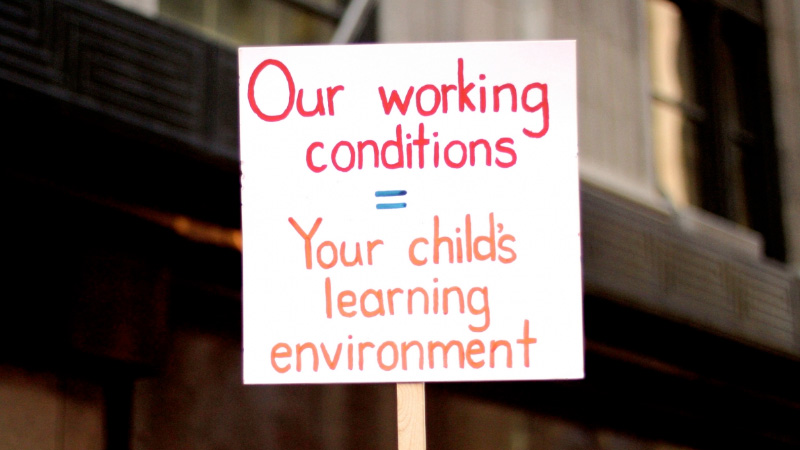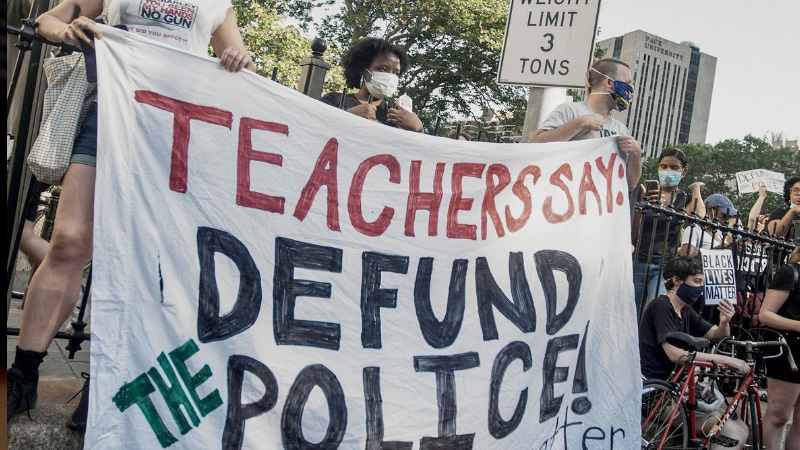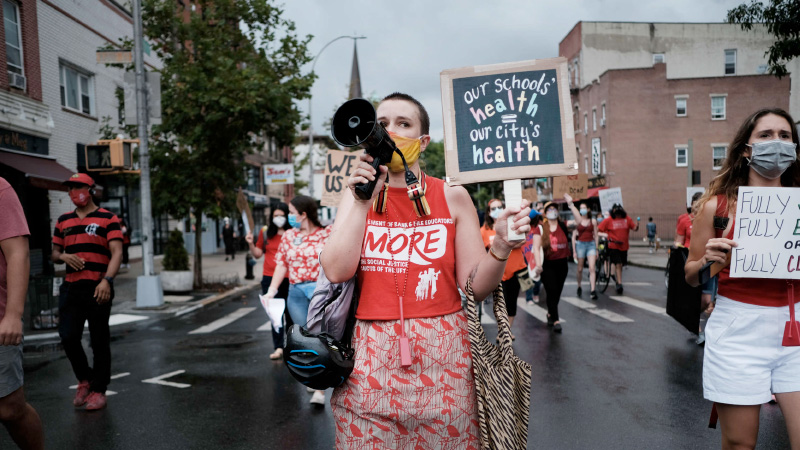The rank-and-file strategy goes to school
Reflections on building MORE

On September 1st of this year, the United Federation of Teachers (UFT) came within hours of authorizing a strike. For the first time since 1975, the union, led by a notoriously timid and sclerotic bureaucracy, seriously began preparing to threaten to withhold its labor. In the end, union president, Michael Mulgrew, called off a planned strike vote just hours before it was to take place, negotiating a deal for teachers and students to return to school buildings with minimal safety protections from COVID-19.
The very willingness of the union leadership to utter the words “job action” was doubtless the result of an upsurge of rank and file pressure unseen in generations. A grassroots-led sickout in March helped to shut down school buildings in the face of inaction from the state and the city, and throughout the summer unease had spread about the Department of Education’s reckless “hybrid” plan for reopening school buildings. In the days before the strike vote, the Movement of Rank and File Educators (MORE) organized a thousand-strong mass strike-prep meeting, the largest rank-and-file led gathering in the union’s 60-year history.

These events are the vindication of almost a decade of organizing inside the UFT and in particular the work done by MORE, a social justice caucus within the union that has grown sevenfold in the last six months to over 750 members. With district-level committees across the boroughs and regular meetings of hundreds of education workers, this enormous and rapid growth was only possible because of years of what civil rights mentor Ella Baker called “spade work”––slow development of one-on-one political relationships––and the painstaking efforts to refine through political debate and discussion the orientation needed to ground genuine progressive insurgency in the union. Because of the groundwork laid and seeds sown, this garden of rank-and-file activism was able to sprout during the COVID-19 crisis.
As a socialist who has been organizing in the UFT rank and file movement for close to twenty years, this experience has drawn out some key lessons that are worth generalizing across the left. First, MORE has validated the importance and effectiveness of the rank and file strategy for building power in the labor movement, and second, it has given some insights into the hotly debated relationship between electoral and movement organizing.The rank and file strategy was developed by socialists of previous generations starting in the 1920’s in the Communist Party and further evolved through the rank and file movements of the 70’s. It is a strategy to connect socialist activists to radicalizing workers, who have been separated by chasms constructed by segregation and redbaiting for long stretches of American history. It underscores that one of the key tasks of socialists is building organizations rooted in the working class that are independent of both the union leadership and mainstream political parties. Absent this kind of organization, broader class upsurges are much more difficult if not impossible. Without MORE, the anger and fear around COVID-19 would have existed but not been able to coalesce and exert real pressure on the UFT leadership to take action.
The success and growth of these rank and file efforts have their own rhythms based in the tides of class struggle, independent of the electoral calendar. Electoral movements can cross-fertilize with labor and social movements but the relationship between them is independent, dialectical, and nonlinear. Finally, the MORE experience validates the need for the intervention of socialist activists in class organizations, helping to build relationships, shape debates, and provide political clarity.
MORE was formed in 2012 out of a fusion of a number of different rank and file formations including the significant, although never dominant, participation of socialist activists from a variety of traditions. It drew on groups of entrenched opposition caucus veterans, newer cohorts from radical pedagogy organizations, the energy of Occupy Wall Street, and the grassroots movement to prevent Mayor Michael Bloomberg’s school-closing and union-busting agenda.
Learning from other rank and file efforts nationally, MORE coalesced around the slogan “our working conditions are our students’ learning conditions,” the group had an orientation on “social movement” unionism but not a lot of clarity as to what it meant in practice to balance between ‘bread and butter’ wage or working conditions demands and broader social justice goals. There were long battles to achieve political unity over how central antiracist demands should feature in the work, in particular support for demonstrations after Eric Garner’s racist lynching by police in Staten Island in 2014. Battles within MORE were often rooted in very real contradictions within the union’s mostly white workforce, which is split between older, more suburban educators and younger teachers more receptive to social justice issues. By 2018, after two successful campaigns in union leadership elections but little sustained growth, a ‘bread and butter’-oriented faction left the caucus to focus on the UFT executive board, leaving a smaller but better unified MORE. Bolstered by a new influx of DSA-radicalized teachers, the caucus re-centered its work on building alliances with parent and student organizations.
This long period of struggle for political unity and clarity was, in retrospect, a precondition for the maturation and growth of the caucus. MORE developed a layer of activists who learned how to translate demands for change in a segregated, racist school system into concrete mobilizations that could stir their coworkers into action. Some of these activists came to the group from the organized left, others did not, but the intervention of the socialist organizations played an important role in grounding the battles in political theory and history, as well as providing the activists who could lay this groundwork.

Teacher unionism in New York has a hundred-year history rich with lessons on how to fight racism and segregation, unite with parents and students, and take on the union leadership. Much of the political education in the caucus was led by socialist activists. Socialist activists often performed the key task of developing the membership structures and meeting routines within the caucus that could help consolidate growth. Labor Notes played a crucial role as well in providing training infrastructure and a framework based on grassroots rather than top-down organizing models.
This process of building infrastructure and learning how to intervene in the union began to create opportunities––around successful campaigns against notoriously abusive principals, for example––but didn’t result in real power shifts in the union. Yet the last six months, leading up to and after the shutdown of school buildings in NYC, have shown how long years of organizing can result in an organization capable of leading significant struggles. In March, hundreds of teachers gathered in a sickout planning call, moving the union leadership from “agreeing to disagree” with Mayor de Blasio on whether to close schools to threatening to take him to the Supreme Court just two days later, ultimately winning school closures the following morning.
As the organization ballooned in size over the summer, rapid organizing turned MORE into the go-to group for media reporting on the situation in the schools, and then into the center for rank and file mobilizations. This meant first backing up the UFT strike threat, and later helping organize walkouts after the UFT led teachers back into unsafe school buildings. The experience has been a validation of the rank-and-file strategy where building organizations independent of the union leadership takes primacy over taking staff positions or vying for electoral power within unions without first building a base.

The MORE experience has revealed useful insights in the debate over the relationship between labor and electoral movements, and how both relate to building an effective socialist left. This has been a point of contention in the past five years since the sweeping radicalization signaled by the Bernie Sanders 2016 campaign and the Red State teacher strikes in the years that followed. Many who will cosign the rank and file strategy have divergent perspectives on the relationship between electoral and labor movements, and I argue here that our experience in New York offers a powerful contribution to these debates. Rather than seeing electoral movements as the primary engine of growth and training ground for the socialist left, MORE shows that building class-struggle organizations is the key ingredient.
On the surface, the history of the group might be read as bolstering the argument that elections helped to provide the activists who helped to lead the current upsurge––without the influx of a “Bernie generation” of young teachers MORE might not have survived the faction fights of 2018 in the way it did. But this argument can easily be overstated. The Bread and Roses DSA current has claimed, for example, that “rank-and-file teachers in New York City used the networks and leadership built through their Educators for Bernie project to help organize and spread a wildcat sickout to demand schools be shut down.” While it is true that a Whatsapp chat dedicated to winning a UFT endorsement for Bernie did rapidly switch gears toward sickout organizing, that ignores the crucial and indispensable role of the rank-and-file organization built up over years in making the March sickout happen. Unless there is a container in which to pour energies gleaned from electoral organizing, it will not necessarily lead to increased struggle.
Others, like Jacobin’s Jared Abbott, acknowledge that electoral and labor activism are “mutually reinforcing activities” but are fundamentally pessimistic about the prospects of class struggle from below. Arguing that “barring legal changes that might tilt the playing field of industrial struggle in favor of workers, a major upsurge in union strength is not going to materialize,” Abbott ignores one of the fundamental lessons of US labor history, that saw the emergence of the 1935 National Labor Relations Act out of the mass socialist-led strikes of 1934: legal reforms flow from social struggle, not the other way around. Abbot instead credits the “skillful” craft of US Senator Robert Wagner’s progressive staff.
If anything has become clear in the recent years of rising class struggle, from the Red State teacher strikes to the COVID-19 wildcat upsurge, it is that radicalization and anger at widespread inequality is spilling over into labor militancy. There is clearly an electoral component to this radicalization, but it is only one component of many.
The MORE experience shows us that, even more important than legislative changes, are rank and file organizations and left/socialist activists on the ground building class struggle formations. Electoral movements, and those radicalized by them, can certainly cross-fertilize with labor organizations. But that cross fertilization must be encouraged and facilitated by an explicit and conscious effort to build independent, struggle-focused labor formations. Making such an explicit and conscious argument is the key role for socialist organization in this period.
There is a related, long and important debate over what kind of socialist organization we need. Abbott and his cothinker Dustin Guastella have argued for a “party surrogate” structure that competes with the mainstream Democratic party as an electoral machine, whether it pushes Democrats to the left or prepares for an eventual break. But this ignores that the central role of a socialist organization lies not solely in its electoral tasks but rather in its constitution as a collective of activists with a task of intervening in movements (whether electoral, labor or broader social struggles) and training the layers of organizers who are capable of intervening effectively. “Intervention” does not mean making pronouncements about what the direction of a rank and file formation should be, or writing abstract proposals about its goals. Instead, the socialist left has to begin with a sense of humility that we have more to learn from the movements than we have to teach. Militants have to learn to develop organic leadership and genuine relationships within those movements that can foster a collective consensus. This includes helping to lead concrete organizing that forges workplace solidarity, broadens the movement, and raises the social questions, like fighting racism, that workplace struggles are already embedded in.
Developing a concrete intervention into the labor movement by building class struggle formations does not mean that socialist organizations should ignore electoral work. Indeed, socialist organizations must find a way to use that electoral activity to train its members in theory and history, as well as concrete movement skills that prioritize relationship building. I think the jury is still out as to whether the grassroots election campaigns of recent years have shown that this kind of training organically emerges from electoral struggles. However, workers who are radicalized by the electoral movements can certainly play a key role in labor formations and socialist organizations should encourage that kind of cross-pollination.
The fate of the New York City schools is very much in the balance, but it is clear that the Movement of Rank and File Educators will play a key role in what happens next. Our ability to do so depends on the granular work we have put in for years building the infrastructure of a class struggle organization, and constructing unity amongst teachers whether radicalized by their segregated, underfunded classrooms or the Bernie campaign (or, most likely, both). Socialist activists from DSA and beyond will continue to learn from the struggle while we contribute to it, and hopefully be able to win more organizers to see themselves as part of a broader radical project to transform society. Crucial to that project will be the active, interventionist orientation of our socialist organizations that don’t just see themselves as cheerleading struggle but rather taking up the important tasks of waging concrete strategic debates and comradely tactical arguments and educating organizers in theory and history.
Categories
We want to hear what you think. Contact us at editors@tempestmag.org. And if you've enjoyed what you've read, please consider donating to support our work:
DonatePeter Allen Lamphere View All
Peter Lamphere is a math and technology teacher and United Federation of Teachers chapter leader (shop steward) in the Washington Heights neighborhood of New York City. He is a 17-year veteran of the teaching force and an active member of Movement of Rank and File Educators, the social justice caucus of the UFT. A lifelong revolutionary socialist, he is part of the Labor Branch of the NYC Democratic Socialists of America chapter.
